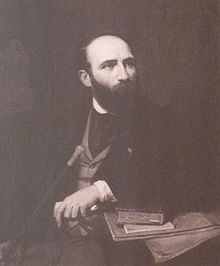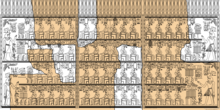Émile Prisse d'Avesnes
Émile Prisse d'Avesnes (Achille Constant Théodore Émile Prisse d'Avesnes, or Prisse d'Avennes , born January 27, 1807 in Avesnes-sur-Helpe , Département Nord , † February 16, 1879 in Paris ) was a French Egyptologist and archaeologist .
With his numerous publications he contributed to the science of Egyptology as well as to the growing public interest in the culture of ancient Egypt . Through his participation in the conception of the world exhibitions of 1867 and 1878 in Paris as well as through his richly illustrated descriptions of the clothes and customs of the inhabitants of Egypt of his time, he was one of the pioneers of Orientalism in European art and popular culture of the second half of the 19th century .
life and work
Prisse comes from an English noble family who had to flee to Flanders around 1680 from the political and religious persecution under Charles II . His father died when he was seven years old. After a short schooling in Trélon and Saint-Aubain, Prisse d'Avesnes entered the École royale d'Arts et Métiers in May 1822 , the former École nationale supérieure d'arts et métiers in Châlons-en-Champagne , which he held up to his 19th year attended.
First he dealt with architectural tasks. A large fountain on the Place de la Bastille as his first project was not carried out. In 1826 he took part in a French expedition in support of the Greek Revolution . A short time later he traveled to Palestine for the first time, visited Jericho and was accepted into the Knightly Order of the Holy Sepulcher in Jerusalem . He then entered the service of the Ottoman viceroy Muhammad Ali Pasha in Egypt , for whom he worked as a civil and hydraulic engineer. His numerous proposals also include a plan for the transport of the obelisk from Luxor to Paris, but the contract for this ultimately went to Jean-François Champollion .
From July to September 1834 he traveled for the first time through the lake region of Lower Egypt and described and mapped the region around Lake Manzala and other ancient ruined cities. A project to drain and reclaim the lake landscape was not carried out. He only worked for a short time as a teacher at the Infantry School of Damiette until, from January 1836, he could finally devote himself to his passion for the culture of ancient Egypt . Together with Jean-François Champollion, he contributed to the deciphering of the Egyptian hieroglyphic writing . Numerous trips took him to almost the entire central Islamic world. Fully adapted to his surroundings in clothing, customs and language skills, he even visited the holy cities of Mecca and Medina .
First works: List of Kings of Karnak, Monuments égyptiens and Papyrus Prisse
Prisse d'Avesnes published his observations incessantly. In 1843 he reported on the flat reliefs in the chapel of the ancestors of Thutmose III. in Karnak , today known as the King List of Karnak and one of the most important documents on ancient Egyptian history alongside the King Lists of Abydos . He had paper moulages made of the reliefs and documented and thus preserved their state of preservation. In 1847 he published a facsimile edition of the Papyrus Prisse, which was later named after him . Also in 1847 his "Monuments égyptiens" and the "Album oriental" were published , in which he presented the clothes, customs and traditions of the people of Egypt of his time.
Against the resistance of the Ottoman authorities, Prisse d'Avesnes collected large volumes of ancient Egyptian works of art, whereby he, like other famous early Egyptologists, above all Giovanni Belzoni , did not shy away from transporting statues and cutting reliefs from their walls. This also includes the King's List of Karnak, which is now in the Louvre , but - without the knowledge of Prisse d'Avesnes - has lost its color due to the improper application of a bitumen varnish . For his services he was appointed Chévalier de la Légion d'honneur in 1845 .
1848–1854: Revue Orientale et Algérienne
The February Revolution of 1848 initially foiled some of Prisse d'Avesnes' travel projects, and he dealt with projects in his native France. His applications for the post of curator of Egyptian antiquities in the Louvre or for the chair of Egyptian archeology at the Collège de France were unsuccessful. He also failed in 1849 with his proposal to take one of the more symbolically more suitable unused sarcophagi from the abandoned quarries of Lower Egypt to Paris instead of red granite from Russia (which could be reminiscent of the defeat in the Russian campaign in 1812 ) for Napoleon Bonaparte's sarcophagus in the Invalides . In 1852–54 he published the “Revue Orientale et Algérienne” , which made the culture of the Orient better known in five volumes.
1858–1860: Trip to Egypt on behalf of Napoléon III.
In 1858 he traveled to Egypt again, where he was commissioned by Napoleon III. led a scientific expedition until 1860. At the same time, Auguste Mariette founded the new Egyptian Museum (Cairo) in Bulaq on behalf of Ismail Pasha . The museum was specifically designed to keep Egyptian antiquities in the country. Known as the “art thief” in the interests of his home country, Prisse d'Avesnes initially had difficulties in getting the viceroy's Ferman , which is necessary for his work . He finally received the permit, but had to undertake not to remove any antiquities from Egypt. He was accompanied by the photographer Édouard Athanase Jarrot (1835–1873) and the Dutch painter Willem de Famars Testas (1834–1896).
For the World Exhibition in Paris in 1867 , Prisse d'Avesne was a member of the commission for the construction of the Egyptian Pavilion and was able to draw on his records and publications when designing individual temples and palace facades. The world fairs played a major role in the subsequent fad of orientalism .
Late work: Histoire de l'art égyptien and L'art arabe
In two large works, richly illustrated with chromolithographs , the “Histoire de l'art égyptien” (1868–1877) and “L'art arabe” (1869–1877), he documented his observations partly in stereoscopic photographs , made them for science and accessible to his contemporaries and preserved the memory of monuments that were soon to be destroyed and scattered by art theft and art trade. “L'art arabe” is one of the early works of Islamic art history , which developed towards the end of the 19th century , and contains one of the first comprehensive documentations of the geometrically constructed patterns of Islamic art . At the world exhibition of 1878 these books received a lot of attention.
Aftermath to this day
Prisse d'Avesnes died in 1878. In 1897 the Rue Prisse-D'Avennes in the 14th arrondissement of Paris was named after him. Edited editions and new editions of his works are still available today.
Catalog raisonné
His main works are:
- 1847 - Monuments égyptiens, bas-reliefs, peintures, inscriptions, etc. Digitalisat (HEIDI)
- 1847 - Fac-similé d'un papyrus égyptien en caractères hiératiques trouvé à Thèbes donné à la Bibliothèque royale de Paris , Paris, Impr.lithographique de Lemercier, 1847: First publication of the Papyrus Prisse .
- 1868–1877 - Histoire de l'art egyptien d'après les monuments depuis les temps les plus reculés jusqu'à la domination romaine , Paris 1878, atlas in 2 volumes with 160 chromolithographs and a text volume formulated by P. Marchandon de la Faye, Paris 1879 digitized (HEIDI)
- 1869–1877 - L'art arabe d'après les monuments du Kaire, depuis le VIIe jusqu'à la fin du XVIIe , Paris. Text volume 1877 digitized (Gallica)
More publishments:
- 1834 - Coup d'oeil sur la situation de l'Égypte en décembre 1831 .
- 1834 - Voyage au lac et à la ville Menzaleh .
- Lettres sur l'Archéologie et la Philologie égyptiennes , letters to the Revue archéologique and to Champollion-Figeac .
- 1845 - Notice sur la Salle des Ancêtres de Thoutmès III, au temple de Karnak .
- 1845 - Research on the Legends Royales et l'époque du règne de Schaï ou Scheraï .
- 1846 - Notice sur le Musée du Kaire et sur les collections d'antiquités égyptiennes de MM. Abbott, Clot-Bey et Harris .
- 1847 - Notice sur les Antiquités égyptiennes du Musée Britannique (British Museum) .
- 1847 - L'album oriental; caractères, costumes et usages des habitants de la vallée du Nil, de la Nubie, de l'Abyssinie et des côtes de la mer Rouge .
- 1847 - Mémoire sur les dynasties égyptiennes .
- 1849 - Fac-similé de papyrus égyptiens. Choix de manuscrits Hiératiques, Démotiques et Grecs. (not published)
- 1852–1854 - Revue Orientale et Algérienne , 5 volumes
- 1852 - Miroir de l'Orient ou tableau historique des croyances, mœurs, usages, sciences et arts de l'Orient musulman et chrétien. (not published)
- 1852 - Des chevaux égyptiens; race ancienne et modern .
- 1852 - Notice descriptive on the work of Général Daumas: Les chevaux du Sahara .
- 1852 - You café, history, culture et commerce .
- 1852 - Les Wahhâbi et la reformation musulmane .
- 1852 - Tribus nomades de l'Égypte, les Ababdeh .
- 1853 - You dromadaire, comme bête de somme et comme animal de guerre ; Book review of the work of Général JL Carbuccia.
- 1853 - Des marbres de France et de l'Algérie, comparés aux marbres étrangers, anciens et modern .
- 1854 - Histoire des armes chez les anciens Egyptiens. (not published)
- 1854 - Des diverse races chevalines de l'Orient .
- 1858 - Notice sur les Papyrus récemment découverts .
- 1860 - Considérations générales sur notre commerce avec l'Égypte et les contrées adjacentes .
- 1870 - De la création d'un Comité oriental au Ministère des affaires étrangères .
literature
- Jean-Marie Carré: Un grand méconnu: Prisse d'Avennes. In: Voyageurs et écrivains français en Égypte. Vol. I, Institut français d'archéologie orientale, Cairo 1956, pp. 301–323.
- Michel Dewachter: Un Avesnois: l'égyptologue Prisse d'Avennes (1807–1879). In: Mémoires de la Société archéologique et historique de l'arrondissement d'Avesnes. Volume XXX, Avesnes-sur-Helpe 1988.
- Ève Gran-Aymerich: Prisse d'Avennes. In: Dictionnaire biographique d'archéologie (1798–1945). CNRS éditions, Paris 2001, ISBN 2-271-05702-7 , pp. 549-551.
- Ève Gran-Aymerich: Prisse d'Avennes Achille Constant Théodore Émile (1807–1879). In: François Pouillon (ed.): Dictionnaire des orientalistes de langue française. Karthala, Paris 2008, ISBN 978-2-84586-802-1 , pp. 783-784.
- Mercedes Volait: Prisse d'Avennes, Émile. In: Philippe Sénéchal, Claire Barbillon (ed.): Dictionnaire critique des historiens de l'art actifs en France de la Révolution à la Première Guerre mondiale . Institut national d'histoire de l'art, Paris 2009 ( Emile Prisse d'Avennes, article on the INHA website , accessed on December 20, 2015).
- Mercedes Volait: Une entreprise autodidacte aux premiers temps de l'archéologie égyptienne: "L'Égypte monumentale" d'Émile Prisse d'Avennes (1807–1879). 2010 ( online on HAL ).
- Visions d'Égypte. Émile Prisse d'Avennes (1807–1879). Exhibition catalog March 1 to June 5, 2011 in the Bibliothèque nationale de France , Paris 2011.
- Mercedes Volait: Surveying monuments in Egypt: the work of Emile Prisse d'Avennes (1807–1879). lecture at the General Consulate of Egypt in Djeddah, November 30, 2013 ( online at HAL ), accessed December 20, 2015.
- Mercedes Volait: Émile Prisse d'Avennes. Un artiste antiquaire en Egypt au XIXe siècle. Institut français d'archéologie orientale, Cairo 2013, ISBN 978-2-7247-0627-7 .
Web links
- Émile Prisse d'Avennes on the page Grandes figures gadzarts (French). Retrieved on December 20, 2015
- Émile Prisse d'Avesnes on egypt.edu; Retrieved December 20, 2015
- Video for the exhibition “Visions d'Égypte” - © BnF 2011 , accessed on December 20, 2015
Individual evidence
- ↑ a b c d Notice biographique sur Emile Prisse d'Avennes. Société d'éditions scientifiques, Paris 1896 ( online at BNF Gallica , accessed December 20, 2015).
- ↑ a b Emile Prisse d'Avesnes: Fac-similé d'un papyrus égyptien en caractères hiératiques trouvé à Thèbes donné à la Bibliothèque royale de Paris. Imprimerie lithographique de Lemercier, Paris 1847 ( online on SUDOC , accessed December 20, 2015).
- ↑ Biography of Prisse d'Avennes, 1934 ( online ; accessed December 20, 2015).
- ^ Exhibition "Voyage en Orient" of the Bibliothèque nationale de France ( online , accessed on December 20, 2015).
- ^ L'art arabe ( Memento of October 18, 2012 in the Internet Archive ). on-line; Retrieved December 20, 2015.
- ↑ Émile Prisse d'Avennes (Ed. Sheila S. Blair): Arab Art . Benedikt Taschen, Cologne 2016, ISBN 978-3-8365-2024-9 .
- ↑ Émile Prisse d'Avennes (Ed. Salima Ikram): Egyptian Art: The complete plates from Monuments Égyptiens / Ägyptische Kunst . Benedikt Taschen, Cologne 2014, ISBN 978-3-8365-1647-1 .
| personal data | |
|---|---|
| SURNAME | Prisse d'Avesnes, Émile |
| BRIEF DESCRIPTION | French Egyptologist |
| DATE OF BIRTH | January 27, 1807 |
| PLACE OF BIRTH | Avesnes-sur-Helpe , North department |
| DATE OF DEATH | February 16, 1879 |
| Place of death | Paris |




